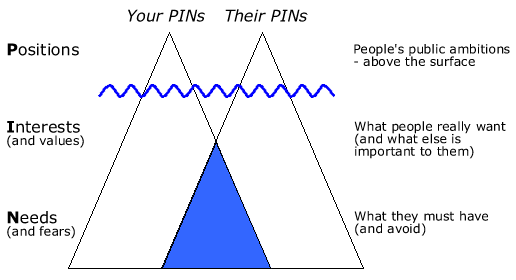Newsletter, February 2007 |
|
Contents this month
Richer conversations
This piece is adapted from a contribution due to be published
in TALKING THE WALK: A Communications Tool Book for Partnership
Practitioners (April 2007) (see: www.thepartneringinitiative.org to access the Tool Book series)
Not all conversations are equal.
There is a spectrum of conversation: at one end there is the sort
of deep and searching conversation that transforms ideas and relationships;
at the other there is something much shallower that changes nothing
and may simply reinforce previous opinions or prejudices.
What makes the difference between richer and poorer conversations?
| Poorer conversations |
Richer conversations |
- Focus on differences and distinctions between things
- Repeat and defend old assumptions and conventional wisdoms
- Try to convince others to accept particular arguments
- Narrow understanding and limit purposes
|
- Bring out the patterns and connections among things
- Explore and question assumptions and conventional wisdoms
- Challenge participants to learn more and search harder
- Expand understanding and build shared purposes
|
This is not to say that a relatively shallow, limiting conversation
does not have its uses when time is short or when understanding
differences are important, or that there are no degrees between ‘richer’ and ‘poorer’ conversations.
But in many contexts, where mutual understanding and shared purposes
are paramount, rich and deep conversation is required.
How do you get beyond the poor and shallow type of conversation
that often breeds confrontation and disagreement?
The two dimensions of conversation
Every conversation has two dimensions: the substantive and the
relational.
The substantive is what the conversation is about; the relational
is how it happens and the effect this has on relations between
those involved.
Rich conversations happen when these two dimensions both go smoothly;
if one doesn’t for some reason, the other will also suffer.
If, for example, someone drones on ignoring the yawns of others,
even if the subject is interesting the conversation will be less
than rich because the relational dimensions has been neglected.
This is not a fair example, you may argue, because a monologue
by one person, with no exchanges, is never a conversation. But
there were exchanges: all those yawns from the reluctant audience.
All conversation involves exchanges - and making rich conversations
depends on being alert to them.
Let’s examine how to improve the substantive and relational
dimensions of conversation separately and then bring them together.
The substantive dimension
How do you transform a conversation made poor through disagreement
about substantive issues to one made richer?
First, you have to invest time and effort in listening so that
you really understand what the other person is trying to achieve,
and why. Don’t assume you know already, and don’t assume
that their interests and yours are the same. Equally, don’t
assume that because you have different interests you don’t
also have compatible ones.
Ask them questions and get them to be as specific as possible
about what they want - when people are anxious or wary they tend
to use generalities. You have to get down to specifics if you want
to find common ground.
It might be useful to use what is sometimes known as the PIN diagram
- PIN standing for Positions, Interests and Needs. It’s a
way of mapping people’s different and overlapping interests
and concerns, and a potent aid to rich conversation.
You could try drawing two PIN diagrams to illustrate where your
needs and interests overlap and where they do not:

Think of these triangles as icebergs. People’s most important
interests, like most of an iceberg, can be beneath the surface.
Simply mapping them like this can help make things clearer.
Doing this does not, of course, make your differences go away.
Yet, as the shaded area suggests, there are usually some common
interests and the more you can develop these, the less important,
in proportion, will be the things that separate you. This is why
the process of expanding interests and understanding is such an
important part of a rich conversation; a poor conversation, by
contrast, is inclined to focus purely on differences as represented
by rival positions.
So the substantive dimension of rich conversation is all about
looking for common ground and building on shared interests.
Ah yes, you may say, but the problem is that we can’t get
to that point: our conversations always become so emotional and
the real problem is that the other person is irrational. How do
we get beyond this?
The relational dimension
Each person’s behaviour towards the other determines whether
the relational dimension leads to a conversation that is rich or
poor. In other words, what you do will influence what they do:
if you confront them, they may confront you; if you try to appease
them, they may take advantage of you and then feel aggrieved if
you then change tack and become more assertive.
So you have to decide as soon as possible what behaviour is most
likely to create the conversation that you want to have. This approach
immediately raises two questions for many people: first, why should
I change my behaviour if it is their behaviour that is the problem?
And secondly, isn’t changing my behaviour to influence others
somewhat manipulative?
Let’s answer the second question first. The reality is that
most of us already use different types of behaviour according to
the circumstances: all I am suggesting is that you do it consciously
rather than unconsciously. In fact, if you don’t adjust your
behaviour and you talk to your boss the same way you talk to your
children, then you have a problem that is beyond the scope of this
article.
Now let’s talk about their behaviour and why it may have
to be you who sets the tone and pace of the conversation.
People bring to a conversation the resources they have. Those
resources may include education, understanding, technical expertise
- and the ability to have a constructive conversation with others.
But if that last ability is lacking, then you have to plug the
gap: you have to help them to have the conversation you both need
to have.
Think of conversation as a dance. Dancing works best when you
both know the steps; if one of you doesn’t, then it’s
up to the other to lead the dance until your partner picks up the
rhythm and the moves. Sooner or later you’ll dance together
without treading on each other’s toes.
| From this |
To this |
 |
 |
|
When icebergs and dancing aren’t enough
So you’ve identified shared interests, built on common ground,
and even managed a few steps in time with the music - but you still
think the other person is just too irrational for any amount of
conversation to work. What do you do then?
First, abandon the idea that the other person is ‘irrational’:
people always act rationally from their point of view. But if the
other person is very different to you, if they come from a different
country, if their education or background or training or understanding
of the world is very different from yours - if, in fact, they are
working off a different map of the word - then yes, they may seem ‘irrational’ to
you.
The problem, however, is not really these differences. The problem
is that in the busy modern world we rush to judgment about what
is rational and irrational because we rarely invest enough time
in conversation.
Rich conversations take time. Sit back and relax, or, better still,
go for a long, long walk to explore your world and their world
and the world you both want to create.
Andrew Acland is the External Examiner for the Partnership Brokers
Accreditation Scheme www.odi.org.uk/pppg/PBAS run by the Overseas
Development Institute and the International Business Leaders Forum.











